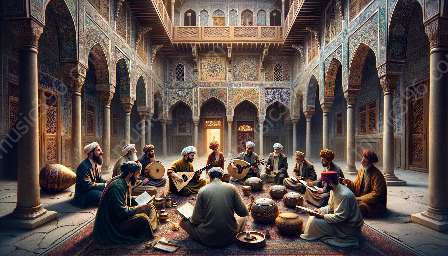Introduction to Middle Eastern Musical Traditions
Middle Eastern musical traditions are deeply rooted in the cultural fabric of the region, reflecting the diverse and complex history, customs, and beliefs of its people. The music of the Middle East encompasses a wide array of styles, genres, and instruments, each with its own unique cultural significance. This topic cluster aims to delve into the rich cultural context of Middle Eastern musical traditions and their relevance in the field of ethnomusicology.
Exploring Ethnomusicology of the Middle East
Ethnomusicology is the study of music in its cultural context, and the Middle East serves as a fascinating area of study within this field. Ethnomusicologists seek to understand how music is intertwined with the traditions, social structure, and history of a particular culture. In the context of the Middle East, ethnomusicology provides insights into the diverse musical practices, rituals, and performances that play a fundamental role in shaping the identity and heritage of the region's communities.
Influences and Elements in Middle Eastern Music
The cultural context of Middle Eastern music is influenced by a myriad of elements, including historical conquests, religious affiliations, migration patterns, and trade routes. These influences have contributed to the development of distinctive musical styles and forms across the Middle East. From the modal systems of maqamat to the rhythmic complexities of iqa'at, Middle Eastern music reflects a dynamic interplay of cultural, linguistic, and religious influences that have shaped its unique identity.
- Maqam System: The maqam system, a modal structure that forms the basis of many Middle Eastern musical traditions, embodies the melodic and improvisational aspects of the music. Each maqam is associated with a particular mood, time of day, or emotion, providing a cultural framework for musical expression.
- Rhythmic Diversity: Middle Eastern music is characterized by a rich tapestry of rhythmic patterns, known as iqa'at, which vary across different regions and traditions. These rhythmic complexities serve as an integral element of cultural expression, often accompanying dance, storytelling, and ceremonial events.
- Instrumentation: The instruments used in Middle Eastern music reflect the region's cultural diversity and historical legacy. From the oud and qanun to the ney and daf, these instruments carry cultural symbolism and are deeply intertwined with the traditions and rituals of the Middle East.
Cultural Expression and Rituals
Middle Eastern musical traditions are deeply embedded in the cultural expression and rituals of the region. From Sufi devotional music to the celebratory sounds of weddings and festivals, music serves as a conduit for the transmission of culture, identity, and communal values within Middle Eastern societies. Whether through traditional folk songs, classical compositions, or contemporary fusion, Middle Eastern music reflects the cultural expressions and rituals that define the region's heritage.
Regional Diversity and Identity
The Middle East is characterized by its diverse array of cultures, languages, and traditions, each contributing to the rich tapestry of musical expression within the region. From the Arabian Peninsula to North Africa and the Levant, each sub-region offers distinct musical styles and practices that reflect the unique identity and heritage of its people. Understanding the regional diversity of Middle Eastern musical traditions is essential in appreciating the depth and complexity of the cultural context within which these traditions are situated.
Legacy and Contemporary Relevance
The legacy of Middle Eastern musical traditions extends far beyond historical contexts, shaping contemporary artistic expressions and global cultural exchanges. The fusion of traditional elements with modern innovations has led to the emergence of new musical genres and cross-cultural collaborations, exemplifying the enduring relevance and adaptability of Middle Eastern music in a rapidly changing world.
In conclusion, the cultural context of Middle Eastern musical traditions offers a captivating lens through which to explore the intersections of music, culture, and identity. Within the realm of ethnomusicology, the study of Middle Eastern music provides valuable insights into the diverse and dynamic nature of musical traditions, offering a deeper appreciation of the region's cultural heritage and its enduring impact on global musical expressions.



































